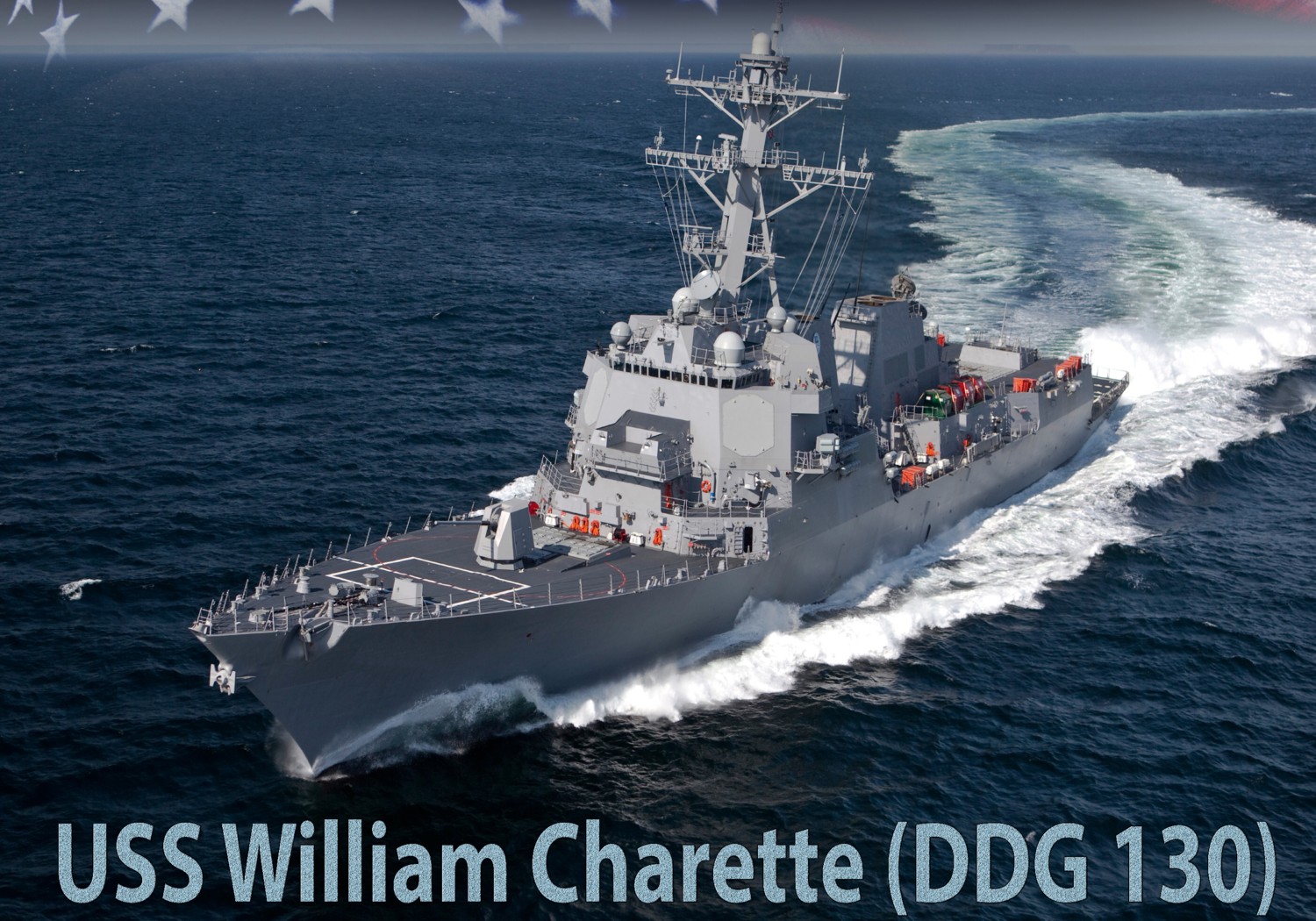William Richard Charette (March 29, 1932 - March
18, 2012)
... was a United States Navy master chief hospital corpsman
who received the nation's highest military decoration for
valor, the Medal of Honor. He was awarded the medal for
heroic actions "above and beyond the call of duty" on March
27, 1953, while assigned to a Marine Corps rifle company
during the Korean War. He retired from the Navy after 26
years of service.
Early life
Charette was born on March 29, 1932, in Ludington, Michigan.
Both of his parents died when he was four and he was raised
by his uncle. He graduated from high school in Ludington, in
1951. He then took a job on a Lake Michigan ferry boat which
led him to join the Navy.
U.S. Navy career
Early career
Charette enlisted in the U.S. Navy on January 11, 1951,
during the Korean War (1950-1953) and underwent recruit
training at Naval Station Great Lakes, Illinois. He then
attended the Hospital Corps School at Naval Training Center,
Bainbridge, Maryland, becoming a Hospital Corpsman upon
graduation. Afterwards, he was assigned to duty at the Naval
Hospital in Charleston, South Carolina. On April 16, 1952,
he was promoted to hospital corpsman third class.
Korea
He volunteered to serve in Korea with the Fleet Marine Force
(FMF) as a hospital corpsman attached to a Marine Corps
unit, and on November 25, 1952, he reported for duty at the
Field Medical Service School, Camp Pendleton, California,
for field training. After completing the course and
graduating as a FMF corpsman, he was assigned to 3rd
Platoon, Company F, 2nd Battalion, 7th Marine Regiment, 1st
Marine Division, which embarked for South Korea on February
5, 1953.
Medal of Honor action
On the night of March 26, 1953, Chinese soldiers in North
Korea attacked, and on March 27, overran two of three Marine
hill outposts in North Korea manned by Marines and corpsmen
from the 5th Marine Regiment, 1st Marine Division, named
Vegas, Carson, and Reno (Vegas and Reno were overrun); Vegas
was considered to be the most important outpost and the
highest outpost that supported the other two outposts. Late
morning that day, a head-on Marine assault was made to try
and retake Vegas with the three rifle companies of the 5th
Marines taking heavy casualties.
Fox Company, 2/7 Marines (2nd Battalion, 7th Marines were
held in reserve) were then committed to the fight for Vegas.
Charette and the other Fox Company corpsmen faced a growing
number of casualties exposed to hostile small arms and
mortar fire when Marines from his rifle company joined in
the counterattack on March 27 against "Vegas Hill" with
Charette's Third Platoon Commander, 2nd Lieutenant Theodore
H. Chenoweth (Navy Cross), leading the assault in
hand-to-hand fighting up the south side of the hill. When an
enemy grenade landed near Charette and a badly wounded
Marine he was aiding, he placed himself on top of the Marine
in order to shield him from the explosion, and in doing so,
the grenade's blast tore off Charette's helmet and destroyed
his medical bag and knocked him unconscious. When he awoke,
he found his face bleeding from shrapnel wounds and he
couldn't see. He recovered enough to continue to aid Marines
in the battle using torn parts of his uniform in order to
dress battle wounds. In another instance, he removed his
battle vest and placed it on another wounded Marine whose
vest was destroyed from another explosion. In yet another
instance, he attended to five Marines who were wounded in a
trench from another explosion, and then stood up in the
trench exposing himself to incoming rounds in order to carry
the one most serious wounded comrade to safety. Charette
sustained painful wounds during the day's battle and was
recommended for the Navy Cross for extraordinary heroism.
While still serving in Korea after the fighting ended there,
he learned that he would receive the United States' highest
military decoration for valor, the Medal of Honor.
Charette was presented the Medal of Honor from President
Dwight D. Eisenhower during a ceremony at the White House in
Washington, D.C., on January 12, 1954. Only five enlisted
sailors were awarded the Medal of Honor for their heroic
actions during the Korean War. All were Navy hospital
corpsmen attached to the Marine Corps. Of the five (Edward
C. Benfold, Richard Dewert, Francis C. Hammond, John E.
Kilmer, and Charette), Charette was the only living
recipient of the medal.
Later career
Charette continued serving in the Navy, training new
hospital corpsmen at the Naval Hospital Corps School in
Great Lakes, Illinois. In 1958, aboard the USS Canberra, he
had the honor of selecting the World War II remains (one
from the Pacific, and one from the European) that would be
placed in the Tomb of the Unknowns in Arlington National
Cemetery.
He eventually transferred to the Submarine Service, becoming
one of the first hospital corpsmen to serve on a nuclear
submarine. He served as an Independent Duty Corpsman (IDC)
in the Navy's nuclear submarine program. He served under
Captain Edward L. Beach, Jr. on the USS Triton, but joined
the crew too late to participate in Triton's historic
circumnavigation voyage in 1960. He was also an IDC on the
USS Sam Houston Gold crew 1962-1965.
Charette's other assignments included the USS Quillback;
Fleet Ballistic Missile Training Center, Charleston, SC; USS
Daniel Webster; Naval Hospital, Orlando, FL; USS Simon
Bolivar; and at the Recruit Dispensary, Orlando, FL.
Retirement
Charette retired from the Navy at the rate (rank) of Master
Chief Hospital Corpsman (HMCM) on April 1, 1977, after 26
years of service.
Death
Charette died at his home in Lake Wales, Florida, on March
18, 2012, due to complications from heart surgery. He was
interred at the Florida National Cemetery in Bushnell,
Florida. He was married for 57 years with four children.
Legacy
On April 30, 1999, the Charette Health Care Center, a part
of the Naval Medical Center Portsmouth, Virginia, was
dedicated in his honor.
AMVETS Post 82 of Ludington, Michigan, was named after
Charette in 1982.
In downtown Ludington, there is a mural dedicated to William
R. Charette. It depicts his tour of duty during which he
earned the Medal of Honor. Charette was able to come to
Ludington and see the mural before his death.
A sign was put up near Spectrum Health Ludington Hospital
that honors him.
A Sea Cadet unit is named in his honor, National Naval
Medical Center Bethesda William R. Charette Battalion.
source: wikipedia
- - - - -
another history:
Charette was born on March 29, 1932, in Ludington, Michigan.
His parents died when he was 5, so he and his sister were
raised by an uncle until World War II. When that uncle was
drafted and sent to war, another uncle took care of them on
a large dairy farm, which Charette helped work into his teen
years.
After high school, Charette worked on a ferry boat on nearby
Lake Michigan. The job inspired his interest in working on
the water, which led him to join the Navy in 1951, shortly
before he turned 19. He was selected to be a hospital
corpsman – a medic – because there was a shortage of them at
the time.
Charette served at a Navy hospital during his first year,
but he later volunteered to attach to a Marine reserve unit.
As a hospital corpsman 3rd class, he joined F Company, 2nd
Battalion, 7th Marines, 1st Marine Division and was sent to
Korea in January 1953.
About two months into the deployment, Charette's unit was
near Panmunjom guarding three hilly outposts along the route
from North Korea to the South Korean capital of Seoul. On
March 27, 1953, Chinese soldiers fighting for North Korea
attacked. Through a barrage of mortar and small-arms fire,
Charette moved from wounded comrade to wounded comrade,
helping them in any way he could.
When an enemy grenade landed near one Marine he was helping,
Charette immediately threw himself onto the injured man,
absorbing the blast with his own body. The explosion ripped
off Charette's helmet and medical aid kit and knocked him
unconscious. When he regained consciousness, he used his own
clothing as bandages to help the other injured men around
him, ignoring his own wounds. One Marine's armored vest had
been ripped off his body by an explosion, so Charette took
off his own and put it on the injured man.
The unit moved toward safety in a trench. They were carrying
a Marine who was suffering from a serious leg wound when
they reached a point where the trench had caved in.
"Where the trench was blown in, they stopped. I was
somewhere toward the rear, so I walked - well, huddled down
- to get up there. I was pretty young and strong at the
time, so I said, 'I'm going to stand up, and you pass him to
me and get someone on the other side to take him, and we'll
just lift him over.’ And that's what we did," Charette said
during a Library of Congress Veterans History Project
interview in the early 2000s.
The 20-year-old hospital corpsman exposed himself to a hail
of enemy fire to make that happen. Using this dangerous
maneuver, the unit got four more injured men across the
blown-in trench and took them to an aid station.
Charette saved several lives that day. He was initially
recommended for the Navy Cross, but that was upgraded to the
Medal of Honor.
"When they came and told me they'd moved it up to a Medal of
Honor, I immediately went to our captain and told him, ‘I
don't want it.’ I didn't think I earned it," Charette said.
"I think it was Ernie Pyle who said, 'You're ashamed to be
alive when you're among the dead.’ And he was right."
Charette accepted the honor, despite never considering
himself a hero. With much of his family present, he and two
soldiers received the medal from President Dwight D.
Eisenhower during a White House ceremony on Jan. 12, 1954.
"You try to wear it in respect for those people who should
have gotten it but didn't," Charette later said.
Five enlisted Navy hospital corpsmen received the Medal of
Honor for actions taken in Korea. Charette was the only
living recipient.
Charette was still in Korea when the armistice was signed.
He left the Navy briefly after returning to the U.S., but he
eventually re-enlisted and served for many years in the
nuclear submarine program. During that time, he married and
had four children.
In 1977, Charette retired as a master chief hospital
corpsman after 26 years of service.
Since then, he has spoken to schoolchildren and various
other groups over the years.
His main message: "You can't forget Korea."
Charette died from heart surgery complications on March 18,
2012, near his home in Lakeland, Florida. He is buried at
Florida National Cemetery.
Medal of Honor citation:
“For conspicuous gallantry and intrepidity at the risk of
his life above and beyond the call of duty as a Medical
Corpsman, serving with a Marine Rifle Company, in action
against enemy aggressor forces in Korea during the early
morning hours of 27 March 1953. Participating in a fierce
encounter with a cleverly concealed and well-entrenched
enemy force occupying positions on a vital and bitterly
contested outpost far in advance of the main line of
resistance, Charette repeatedly and unhesitating moved about
through a murderous barrage of hostile small-arms and mortar
fire to render assistance to his wounded comrades. When an
enemy grenade landed within a few feet of a Marine he was
attending, he immediately threw himself upon the stricken
man and absorbed the entire concussion of the deadly missile
with his own body. Although sustaining painful facial
wounds, and undergoing shock from the intensity of the blast
which ripped the helmet and medical aid kit from his person,
Charette resourcefully improvised emergency bandages by
tearing off part of his clothing, and gallantly continued to
administer medical aid to the wounded in his own unit and to
those in adjacent platoon areas as well. Observing a
seriously wounded comrade whose armored vest had been torn
from his body by the blast from an exploding shell, he
selflessly removed his own battle vest and placed it upon
the helpless man although fully award of the added jeopardy
to himself. Moving to the side of another casualty who was
suffering excruciating pain from a serious leg wound,
Charette stood upright in the trench line and exposed
himself to a deadly hail of enemy fire in order to lend more
effective aid to the victim and to alleviate his anguish
while being removed to a position of safety. By his
indomitable courage and inspiring efforts in behalf of his
wounded comrades, Charette was directly responsible for
saving many lives. His great personal valor reflects the
highest credit upon himself and enhances the finest
traditions of the United States Naval Service.”
source: US DoD
|
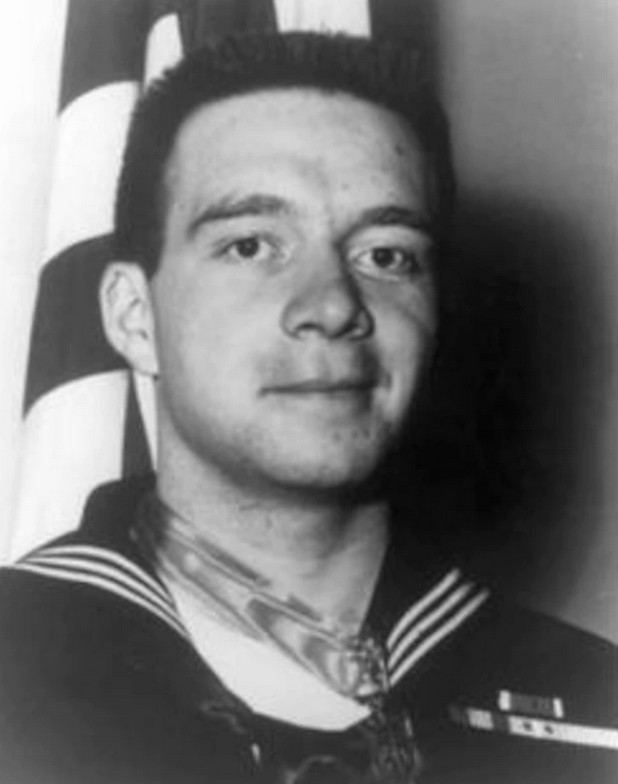
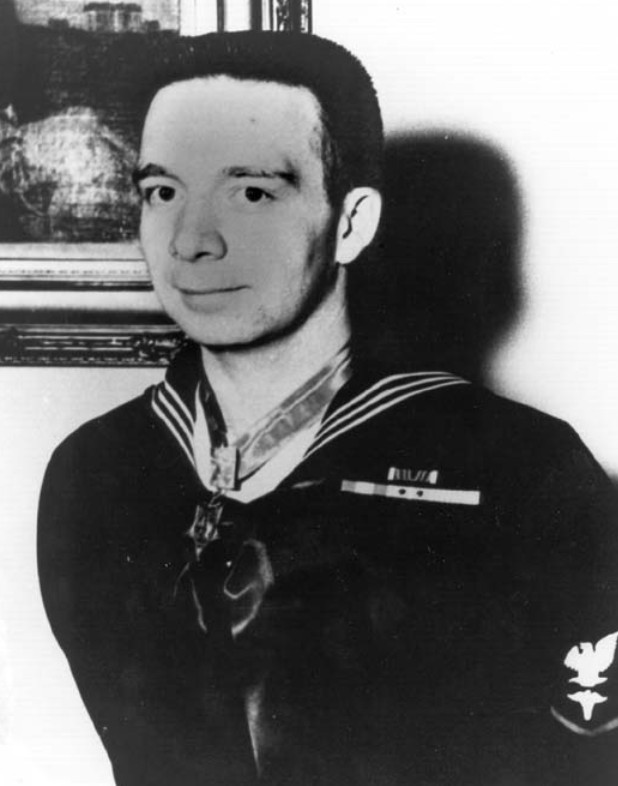
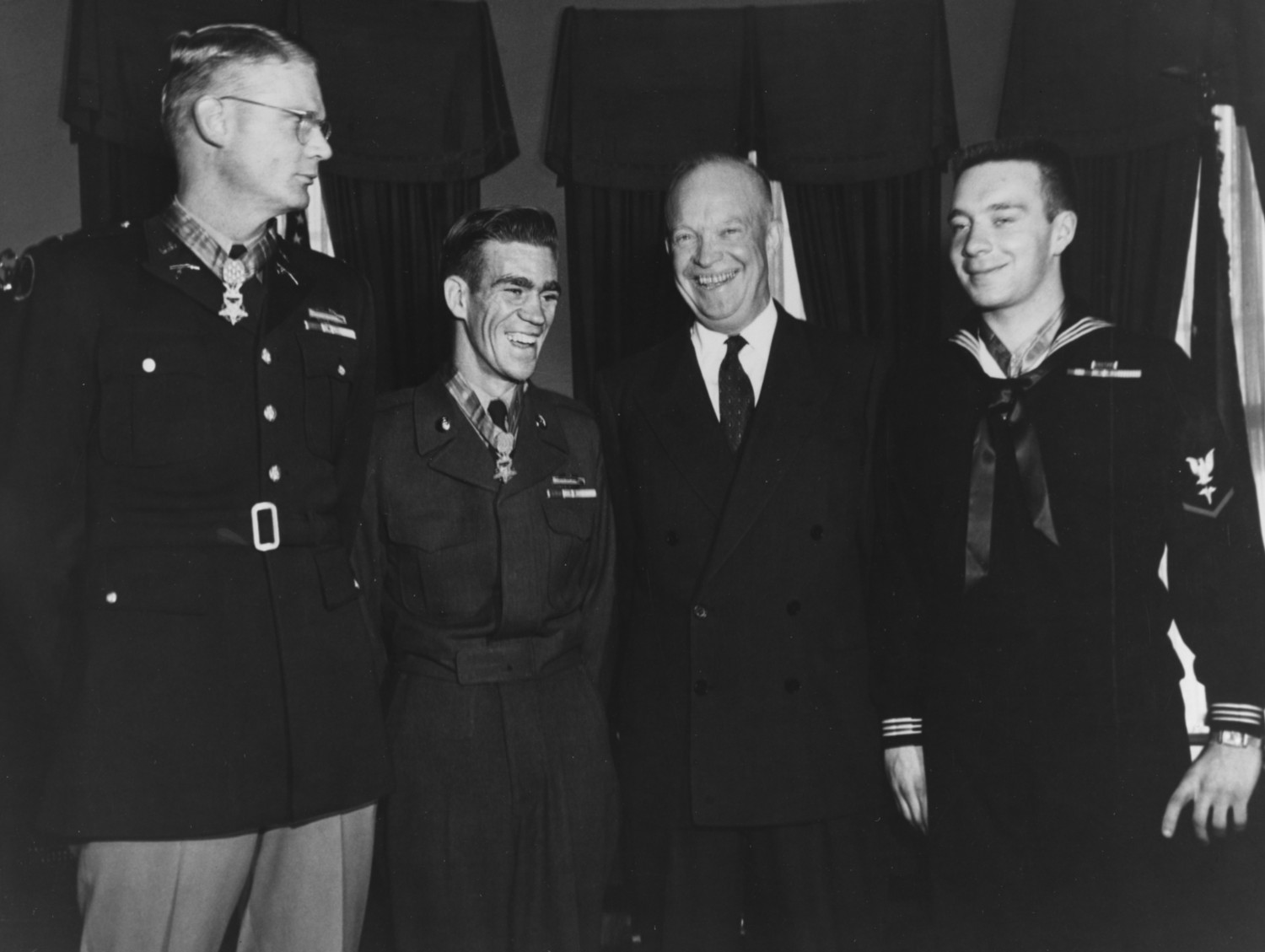
President Dwight D. Eisenhower poses with three men to whom
he has just presented the Medal of Honor for conspicuous
gallantry in Korean War combat action, at the White House,
Washington, D.C., 12 January 1954. Those who received the
medal are (from left to right): First Lieutenant Edward R.
Schowalter, Jr., U.S. Army, honored for his actions near
Kumhwa, Korea, on 14 October 1952; Private First Class
Ernest E. West, U.S. Army, honored for his actions near
Sataeri, Korea, on 12 October 1952; and Hospital Corpsman
Third Class William R. Charette, U.S. Navy, honored for his
actions in Korea on 17 March 1953
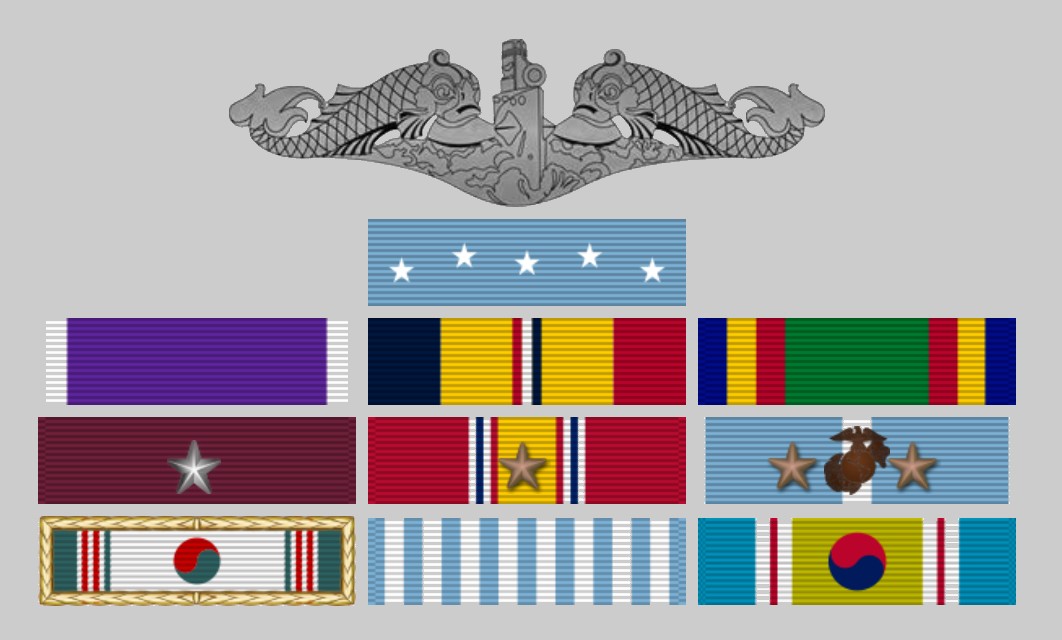
decorations + awards
|
|

